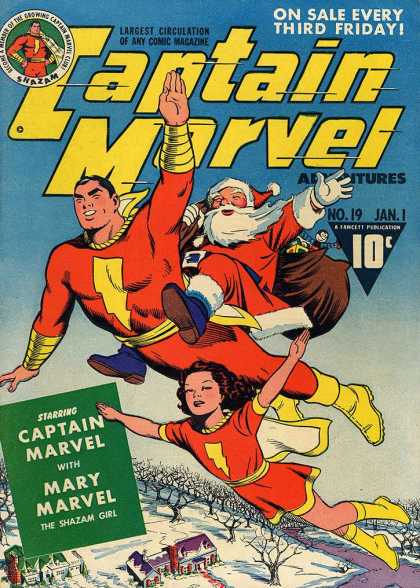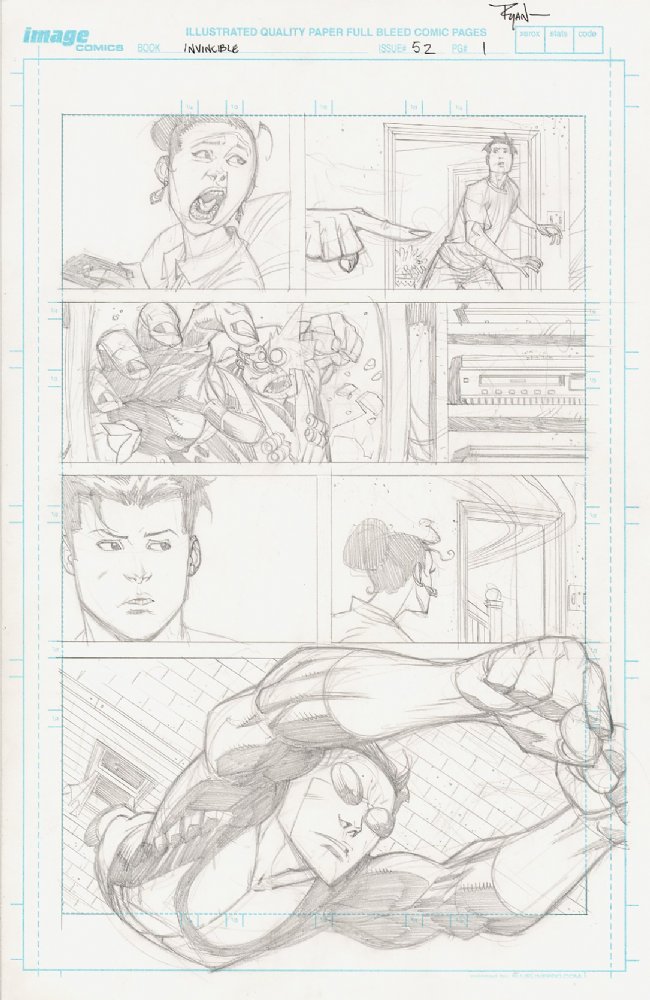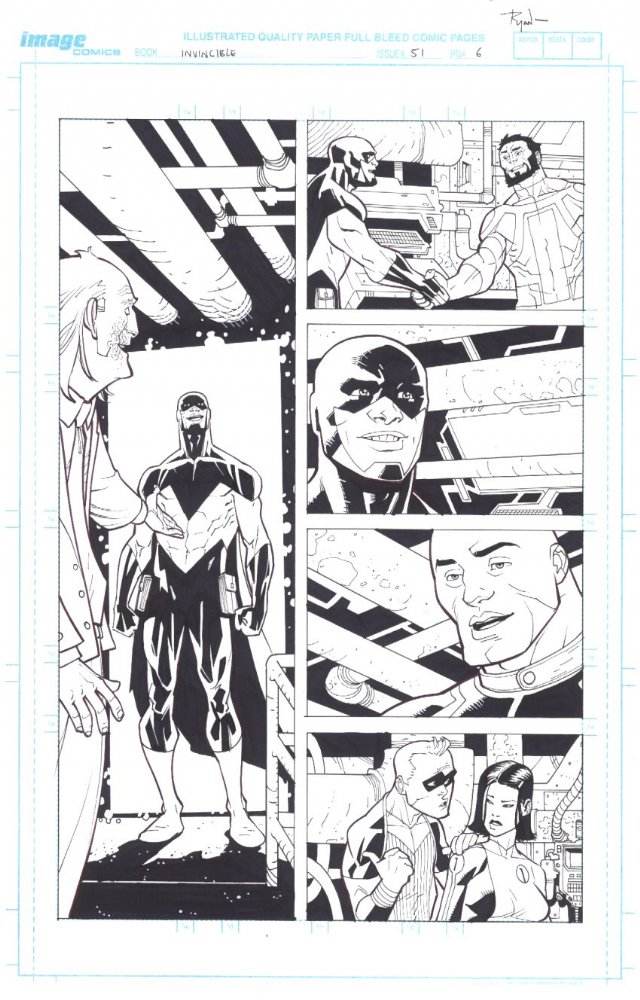 Con season is over, the leaves have started falling, and the weather is getting mighty chilly around these parts. What that means is we’re not too far away from the holiday season, and for many of you the holidays = gift giving and receiving. In the spirit of gift-giving, I wanted to spend some time this week discussing the original comic book art market.
Con season is over, the leaves have started falling, and the weather is getting mighty chilly around these parts. What that means is we’re not too far away from the holiday season, and for many of you the holidays = gift giving and receiving. In the spirit of gift-giving, I wanted to spend some time this week discussing the original comic book art market.
- From the creator directly
- From a primary art dealer
- In the secondary market
- Maintaining a web presence for display and sale of artwork
- Cataloging and indexing of the available pages including scanning, detailed descriptions
- Setting up the pricing of pages, leveraging their experience to find a balance between maximum profit and sustaining demand
- Handling the financial payment, clearing and shipment of the art
- Promoting the artists work to an existing network of buyers
- Promoting the artists work to new potential buyers
- Making pages available at conventions and other viable events
Pencils vs. Inks – The most common method for creating comic book art is for someone to pencil images and then another creator putting inks over top of the pencils to add texture, definition and finishes. The greatest art (IMHO) is a collaboration of the two into a finished image. As a potential buyer, you need to be mindful of whether you’re buying a penciled page or a pencil and inked page. Typically if a page is only penciled, it won’t be as expensive as an inked page from the same book. Pencils are also not as dark and defined and thus won’t photograph as well or be as visible if you’re displaying them as art on your walls. On the other hand oftentimes a penciled page can show off subtleties in the work that can be lost when inks are overlaid. It’s truly a matter of personal preference – I own examples of both. Here are two examples, with the left image being a penciled page from Invincible by Ryan Ottley while the right is a penciled and inked page from another issue of Invincible.


Size of the artwork – The most common size of an original page of comic book art is 11” x 17”, usually on Bristol Board. But don’t presume what you’re buying will be that size; always confirm first. Some artists have their own processes and work at a different scale. For example, I know Alex Ross often paints on canvasses of varying sizes.
Word balloons – The evolution of digital lettering has forever changed the way original comic art looks. Most likely any comic art you buy from a modern comic is going to be without word balloons. They are added digitally in post production (along with the coloring process). But not too long ago, word balloons were physically created and overlaid onto the art. This makes for a very different finished product as an art buyer. I love the nostalgic feeling of owning a classic page where the letters are pasted onto the Bristol Board, but there’s also something to be said for the modern approach where the visuals stand alone as an image without being ‘crowded’ by the word balloons. This, again, comes down to personal preference with one caveat. If you want to own artwork from any classic creators not currently producing, chances are you’re going to need to buy pages with word balloons.
Coloring? – A lot of first time art buyers are confused by the lack of color in the finished pages. Understand that the vast majority of comic book art is not colored. Coloring, even going back to the 4-color days, has usually been done in post production (i.e., after the art has left the creators hands and made its way to the publishers). Today the vast majority of color is done digitally, and thus never touches the physical copy of the penciled and inked image. For those who crave color, may colorists offer color guides and color reproductions, but keep in mind that this is not generally considered the same thing as buying original pages. There are exceptions to the rule of coloring, as creators today utilize multiple disciplines. Painted works – by definition – are done in color and sold as originals. Just keep in mind that generally a painted work – because of the time and complexity of the process – is all things being equal going to be more expensive than a comparable page done in pencils and inks.
- Covers are the pinnacle – Images used as covers typically fetch the highest prices. Candidly, I don’t buy cover art for that reason. But many serious collectors covet covers and thus you can expect a cover of a given book to fetch 5x-10x the price of an average page of the same.
- Splash pages are artist’s money makers – A splash page is usually made up by a single panel or image, and traditionally also comes at a big moment in a given comic book; whether it be a big reveal, or the climax, or a huge action sequence. Much like covers, splash pages usually are the most in demand and can fetch prices significantly higher than any other pages in a book.
- In costume face time = more value – As a general rule of thumb, the more face time a main character gets on a page, the costlier the page.
- Talking heads = least expensive – The converse of the face time rule. If a page features secondary characters, particularly those out of costume, or is largely background scenery, the price of the page is generally much less expensive than the average page
- Historically inkers are given 1/3rd of the pages of an issue they ink while the penciler keeps the other 2/3rds – many times inkers use different art dealers and have different views on the value of a page than the inker of said page
- Negotiations are perfectly reasonable so long as you’re polite. As with anything, an artist or dealer’s willingness to deal is going to come down to the magnitude of your offer. I’ve had success negotiating particularly when I’m looking to buy multiple pages from the same artist/dealer
- Many artists and dealers will offer sales that coincide with the year end or toward tax season
- Always be informed before you buy. Any dealer (primary or secondary) or artist that’s not willing to answer your questions is probably not someone you want to do business with. But also don’t hound them, they should get back to you in a reasonable time frame even if it’s just to let you know they’re busy and when you can expect a more detailed answer
- As artists continue to evolve into the digital realm, it stands to reason that the supply of finished original pages will ebb
- Don’t assume because you can’t find an artist’s pages easily on Google that he/she aren’t open to selling them. Many artists, particularly up and coming ones, are happy to sell their pages but haven’t yet streamlined their own process
Jason is a mutant with the ability to squeeze 36 hours into every 24-hour day, which is why he was able to convince his wife he had time to join the iFanboy team on top of running his business, raising his three sons, and most importantly, co-hosting the 11 O'Clock Comics podcast with his buddies Vince B, Chris Neseman and David Price. If you are one of the twelve people on Earth who want to read about comics, the stock market and football in rapid fire succession, you can follow him on Twitter.


I like city scapes and architecture in my pages and only purchase what I can afford.Any extra cash I may have usually goes to getting sketches done at the 1 con I can go to.
Wait, YOU were the guy who got Fowler’s Deadpool/Wolverine commission? My envy knows no bounds, Wood.
A great article from a part of the hobby that I don’t hear enough about. My page from Y The Last Man is one of my favorite things and it’s the first thing people see when they walk into my apartment. I saved up to get myself an X-Men cover when I got a new job a few years ago and it is so cool to have. I don’t know if they were good investments, but I love having them. Next I’m going to save to buy an original Kirby and an Eisner (I’ll be saving for quite some time for those, but I’ll probably explode with joy when it actually happens). I can’t stress enough the point that he made about inkers in "other tips and tidbits." I got a few pages that I loved by checking out the inker’s page rather than the penciler’s.
Jumping Jupiter’s guide to collecting original art.
Step 1: Be rich.
Step 2: Buy art.
Step 3: Your rich, you get to do what you want.
I’m with Jumping Jupiter on this one – even low-end pages – $50 – $75 a pop – are just too rich for my blood. When I’m at a show, I see too many comics I want, let alone pages (or statues or figures for that matter).
However, one page I’d give my right leg for is Herr Starr hopping across the desert from Preacher – 9 panels of awesome.
I got a chance to visit the home of a pretty famous comic art collector last year. To see all that work together on the wall is incredible. He of course enjoyed every piece, and for him it had more value than dollar amounts..he was a giant fanboy at heart, and could tell you every detail about the characters he collects. I envy his disposable income collecting but i’m glad good work goes to enthusiasts like that.
I was checking out an auction catalog for a firm in Dallas that specializes in illustration and comic art (can’t remember the name right now) and it was amazing at some of the low reserves in there for super famous artists compared to other fields of art and illustration. It was also amazing how many con sketches are in there. I’m sure those help to saturate the market and kill prices for those creators.
do the inkers work on vellum or over digital pencils or something?
I wish I could afford a piece of art. 900 dollars is to steep for me.
@Jumping Jupiter and Dan: I have to disagree. I’m no one’s definition of rich, but I just set aside 10 bucks a week or so and any holiday money I might get and buy a couple of pages a year. I’ve gotten quite a few pages that I really like that way. Of course, it’s all a matter of what you want to collect (back issues, statues, etc), but you certainly don’t have to be rich to collect them. Although, come to think of it, collecting original comic art would be a lot easier if I was rich.
@Dan-I’ve actually only seen and available page of Preacher for sale once. It was for $150 online and I saved for months to get it. They sold it just a couple weeks before I had all the money together (It was disappointing, but I just tell myself that’s part of the thrill of the hunt).
Great article. Something it didn’t address though was inked sketches from conventions. If money is tight this is the way to go. I’ve gotten great stuff with prices ranging from free to around $50. The only thing is the dockets of the most popular artists fill up fast so get to them early. If its a multi-day con you may have to pick up your art on a different day. Incidentally, are their 2 or 3 art dealers that are recognized as THE dealers for original art? It’s usually out of my range but I can see myself doing a once every couple of year splurge.
I bought a penciled page of Invincible, after it was printed in the comic. It was then I realized that the inker and colorist got a scan of the original.
But TWD page I got, Adlard draws and inks.
Great article! I just bought a BPRD page from Guy Davis at a convention last weekend. I can’t wait to get it framed and up on my wall.
i’m surprised more comic artists don’t make and sell silkscreen or digital prints of their work. Its a very popular route for many illustrators and a way to get lower priced work into the hands of more fans. It also enables you to hold on to that original or get more for it. You do a run of 150 signed and numbered prints its a good deal for all involved.
@Collosus: That’s a great thought but that ten dollars you put aside, exceeds my weekly comic book budget. And I scrape to be able to reach that.
I’m poor. That’s not hyperbole. My salary is below the provincial poverty line. I eat, pay the rent and electricity and that’s about it.
Rich in my mind means having disposable other than a few dollars a week.
Great article. I have a question though as I’m an OA n00b. I recently bought a few pages of Chew from Rob. It’s definitely the inks, but it looks like the prelim work was done in some kind of red pencils where everything is laid out. What are those reds referred to as? Also, what does "blue line" refer to?
@400yrs…Rob uses Red pencil lead. I read about his process somewhere…his blog or in a book or something. They make the same in Blue. Blue line or "Non Photo Blue" is an old graphic design term referring to colored ink/pencil that won’t show up when photographed (the old process of getting a layout onto plate to go to press…hence the term ‘camera ready art’) I’ve seen other illustrators and animators outside of comics use this technique as well. They still use it today for scanning. You can set up your scanner to not see those Red and Blue lines. So you can draw loose, ink tight, and your underlying work doesn’t need clean up later after you scan.
Goddamnit Wood, you have some amazing art pieces. My envy knows no bounds. I’m definitely interested in picking up some original pieces…once I convince my wife that a man cave is a complete necessity for me. Thanks for all the tips.
I recently got into buying original art and one thing I overlooked was how expensive getting pieces framed can be. Having said that, getting it properly framed can really make the art pop.
@mario If you frame them yourself you can save a bundle.
I collect original comic art as well as screen print rock show posters. If you watch Hobby Lobby, you can pick up frames or frame kits for 50% off when on sale (which is like once a month). Ikea is also an inexpensive source for decent frames. But by far the best way to acquire cheap frames is Goodwill or garage sales. Just keep a list of frame measurements that you need in your wallet and you will always be prepared.
Great article, Mr Wooood
I would also recommend either to see the page (.jpeg,etc) or to know its condition before commiting to a purchase. Old pages can at times be damaged, torn or creased from being folded in half, and pages bought on the secondary market may have been personalized.
There are art dealers at the larger conventions who have tables covered with original art. You’ll see pages from the biggest names of the Silver Age going for very low prices because they’re not currently "hot."
One thing not touched on: If you want to become a comic artist, there is a ton of info in pages of original art with well drawn characters, buildings, vehicles and what not but no costumed characters. There’s a lot of education to be had for a fraction of the cost of a typical textbook.
Sometimes, it takes looking at the original art to see it as something a human produced. Sounds strange, but often it’s the imperfections that inspire a would be artist.
Good article.
I use frames from this company:
http://www.posterframedepot.com/
They’re affordable and easy to put together.
Here’s my favorite art dealer:
http://www.splashpageart.com/
Top-notch selection and great to deal with.